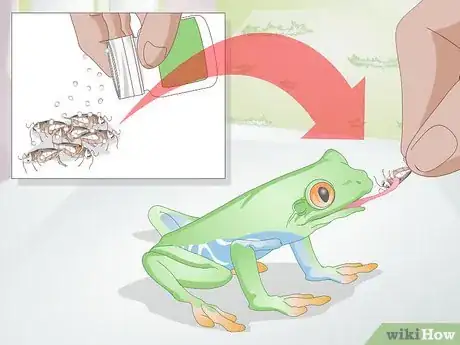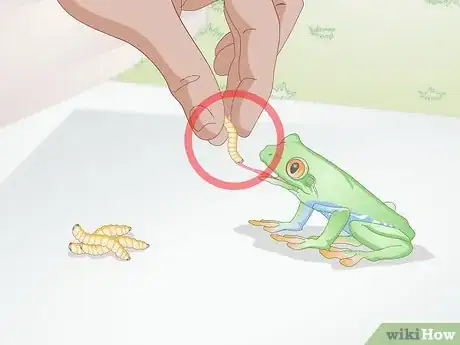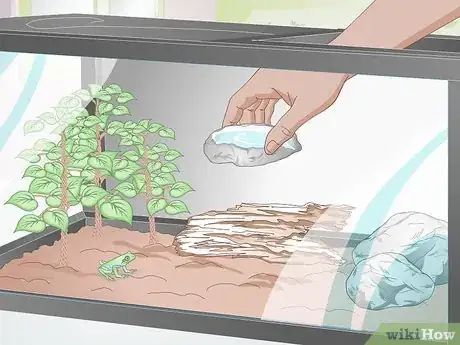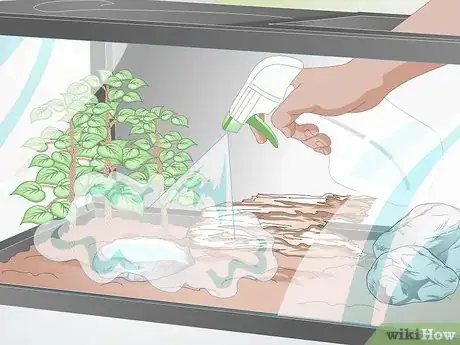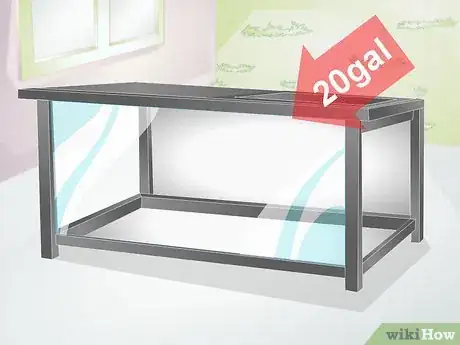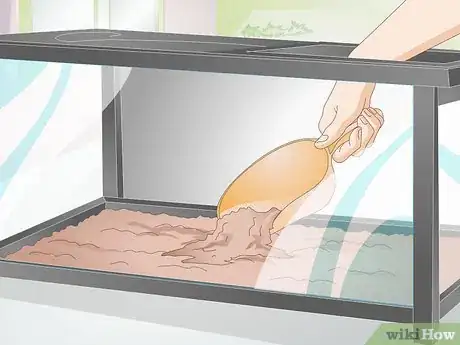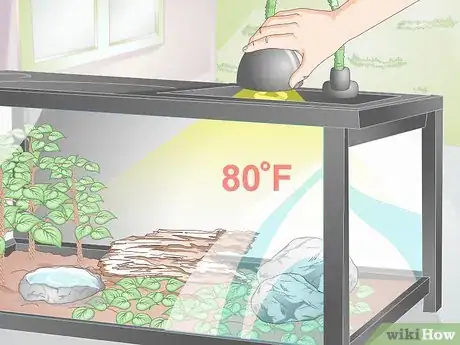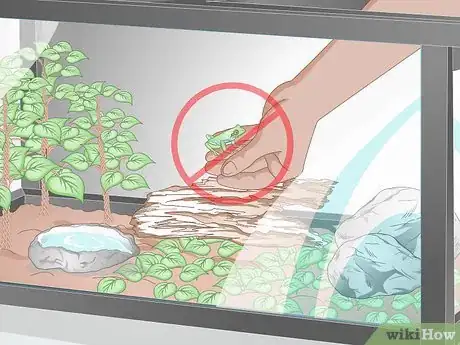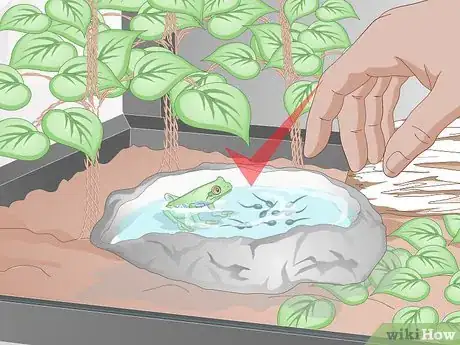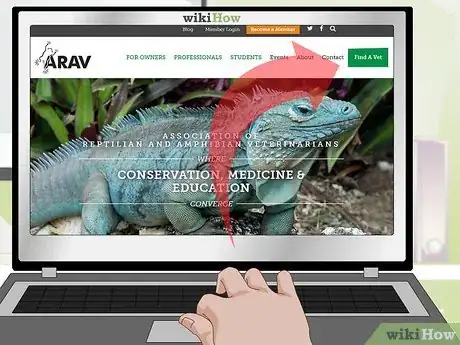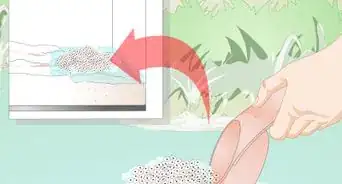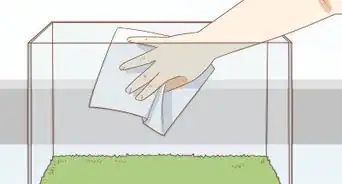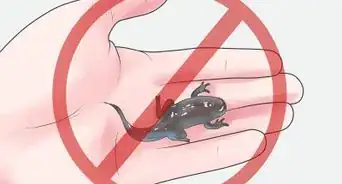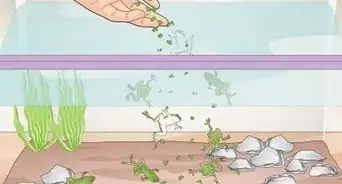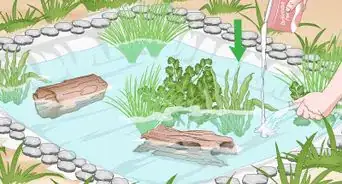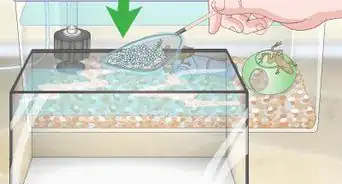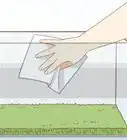This article was co-authored by Pippa Elliott, MRCVS. Dr. Elliott, BVMS, MRCVS is a veterinarian with over 30 years of experience in veterinary surgery and companion animal practice. She graduated from the University of Glasgow in 1987 with a degree in veterinary medicine and surgery. She has worked at the same animal clinic in her hometown for over 20 years.
There are 17 references cited in this article, which can be found at the bottom of the page.
This article has been viewed 126,253 times.
Red-eyed tree frogs are a beautiful and exotic species of frog, especially for amphibian lovers. It is important to make sure they have the best care possible. Your frog requires a special diet of gut-loaded crickets and plenty of water to stay hydrated and cool. A natural, comfortable shelter is important as well. Red-eyed tree frogs are delicate so it is important to handle and treat them with gentleness and respect.
Steps
Feeding and Hydrating Your Frog
-
1Gut-load your crickets. Before you feed your frog, you should feed its prey. Crickets are the primary food source for captive red-eyed tree frogs. One or two days before you feed your frog, feed the crickets a mix of dried and fresh foods to ensure that they are full of essential nutrients. Some good foods for crickets include crushed dog or cat food pellets, commercially produced cricket feed, mixed seeds, alfalfa, lettuce, broccoli, carrots, and fruit.[1]
- For adult frogs, dust their prey with reptile calcium/vitamin D3 supplements once a week. For younger frogs, you may have to do this every day. This will ensure that your frog is receiving all of its proper nutrients.[2]
- The crickets you feed your frog should be no larger than their head. For young frogs, make sure that they are no bigger than a quarter of an inch long.[3]
-
2Feed your frog insects every two or three days. Red-eyed tree frogs are insectivores, which means that they eat bugs and insects such as grasshoppers, crickets, and moths. You can buy live crickets from a pet or reptile store. Feed your frog around fifteen live crickets every two to three days.[4]
- Red-eyed tree frogs will occasionally eat worms as well. Wax worms are recommended for this. Do not feed them meal worms. Not all frogs will accept worms to eat, however.[5]
Advertisement -
3Provide a water dish. A wide, shallow water dish will allow your frogs to drink and hydrate. A water dish is essential because it will allow the frog to cool down if they are too hot or wash down if they become too dry. It can even increase the humidity in the terrarium.[6] A heavy plastic or clay water dish will prevent spills.
- Water should be changed every day.[7]
- If you have many frogs in one cage, you might want to have multiple water bowls.
-
4Spray the terrarium to increase humidity. Red-eyed tree frogs need a humidity of around 90%.[8] To help maintain the humidity, spray the terrarium with a water-filled spray bottle twice a day. Spray the walls, substrate, and furnishings.[9]
- If your frog’s skin is looking dry, you can even spray them. Be careful not to spray them in their face.
- You can also invest in an automatic misting system. These are expensive, but they will handle the spraying process to ensure that your frogs are properly hydrated.
Creating a Safe Habitat
-
1Invest in a glass terrarium. You will need at least a ten to twenty gallon glass terrarium for your tree frog. This size can accommodate up to four frogs comfortably. Make sure that you have a properly fitting screen-top. This will ensure proper ventilation while keeping everything secure in your frog’s habitat.[10]
- Pet stores will often sell these terrariums. You will also be able to find them online. Remember the more frogs the larger the terrarium will have to be.
-
2Lay down a proper substrate. The material lining the bottom of the cage is called a substrate. For your red-eyed tree frog, you should put down about two or three inches of non-fertilized potting soil. You can mix this soil with bed-a-beast bedding, orchid bark, coco coir, paper towels, or peat moss to give it more texture.[11] [12]
- The substrate should be scooped out and replaced every two to three months.[13]
-
3Furnish with leaves and natural décor. Your frog will appreciate some items around the cage to climb and hide under. Find some natural, leafy looking furnishings to place in the cage. Make sure that these are non-toxic to prevent damage to your frog's sensitive skin.
-
4Keep the habitat warm. During the day, the cage will need to be between 78 and 84 degrees F (25 and 28C). At night, the temperature can drop no more than ten degrees. If your room temperature is cooler than this, you may have to invest in heaters for your terrarium. There are several options for heating the terrarium:
- Low wattage heat bulbs can attach to the screen top. They provide enough heat without burning your frogs.
- Heat pads can rest beneath the cage. Look for ones specially designed for reptiles at your pet store.[16] Be warned that if water touches the hot glass, it can crack the glass.[17]
- Red or nocturnal bulbs can be left on all night to ensure around the clock warmth.[18]
- Red-eyed tree frogs are nocturnal so extra lighting isn’t necessarily. Bulbs would simply provide warmth.
Taking Care of Your Frog’s Health
-
1Clean the cage regularly. The frog’s enclosure should be cleaned once a week. Remove all of the furnishings, and wash them with hot water only. Do not use soap; this could irritate your frog’s skin.[19] Remove visible debris from the substrate, such as leftover cricket parts or feces. The substrate itself only needs to be replaced every two to three months. Mist and wipe down the terrarium walls, but do not use commercial cleaning solutions or soap.[20]
-
2Avoid handling the frog. Frogs are not pets that should be handled often. They may be skittish and afraid of human contact. In addition, their sensitive skin means that human skin can irritate them. Only handle your frog when necessary, such as during cleanings or if taking the frog to a vet.[21]
- To pick up a frog, dampen a dip net, and gently coax the animal inside. Place your hand over the net to prevent the frog from jumping out as you lift the net.[22]
- If you do have to handle your frog, wash your hands first. Keep your hands damp after washing. Frog skin burns when it is in contact with dry human skin.
-
3Give tadpoles plenty of space. If you have multiple frogs in a terrarium, you may find that your females have laid eggs. Red-eyed tree frogs can lay up to 100 eggs at a time. The eggs will hatch after 9 days, after which you will have dozens of tadpoles in your water bowl or reservoir. Make sure that the tadpoles have at least two or three inches of water. Feed them crushed fish food until they can walk.[23]
- If they are swimming on top of one another, they don’t have enough water. Add more water to give them some space.
- You may not be able to accommodate so many frogs at once. Be prepared to find these frogs new homes once they grow up. You can call a local pet store or post ads on local pet forums.
-
4Find a herpetarium veterinarian. If your frog is showing signs of low energy, appetite, or other unusual behavior, you will want to take it to see a vet. You should find a herpetarium vet who specializes in caring for reptiles, amphibians, and invertebrates. These can be very difficult to find, so locate one before your frog becomes sick.[24]
- To find a herp vet, you can contact local veterinary schools, or you can look through the member listings of the Association of Reptilian and Amphibian Veterinarians.[25]
Warnings
- Long exposure to heat or low humidity will kill these frogs⧼thumbs_response⧽
- Always wash your hands before and after you've handled the Red-eyed tree frog.⧼thumbs_response⧽
- This species of frog is stressed very easily. Red-Eyes are more sensitive than most other frogs.⧼thumbs_response⧽
- Don't use gravel unless it is absolutely necessary. Sometimes the frog will lunge for a cricket, miss, and eat the gravel. This is very dangerous.⧼thumbs_response⧽
- Avoid handling them as much as possible. It can cause illnesses from the lotion, soap, and scent.⧼thumbs_response⧽
- If you believe your frog is sick, waste no time and get medical attention immediately. Better safe than sorry.⧼thumbs_response⧽
References
- ↑ http://cricket-breeding.com/what-to-feed-crickets/
- ↑ http://amphibiancare.com/2007/11/19/redeyedtreefrog/
- ↑ https://www.lllreptile.com/articles/116-red-eyed-tree-frogs/
- ↑ http://www.reptilesncritters.com/care-guide-red-eyed-tree-frogs.php
- ↑ http://www.redeyedtreefrog.com/Red-Eyed/red-eyed.html
- ↑ http://www.redeyedtreefrog.com/Red-Eyed/red-eyed.html
- ↑ http://www.anapsid.org/greentreefrog.html
- ↑ http://www.redeyedtreefrog.com/Red-Eyed/red-eyed.html
- ↑ http://www.redeyedtreefrog.com/Red-Eyed/red-eyed.html
- ↑ https://www.lllreptile.com/articles/116-red-eyed-tree-frogs/
- ↑ http://www.reptilesncritters.com/care-guide-red-eyed-tree-frogs.php
- ↑ http://www.reptilesmagazine.com/Frog-Amphibian-Species/Red-eyed-Treefrog/
- ↑ http://amphibiancare.com/2008/05/27/terrarium-and-vivarium-maintenance/
- ↑ http://www.reptilesncritters.com/care-guide-red-eyed-tree-frogs.php
- ↑ http://www.anapsid.org/greentreefrog.html
- ↑ http://www.lllreptile.com/products/106-zoo-med-10-to-20-gallon-heat-pad
- ↑ http://www.reptilesncritters.com/care-guide-red-eyed-tree-frogs.php
- ↑ https://www.lllreptile.com/articles/116-red-eyed-tree-frogs/
- ↑ http://www.anapsid.org/greentreefrog.html
- ↑ http://www.reptilesncritters.com/care-guide-red-eyed-tree-frogs.php
- ↑ https://www.lllreptile.com/articles/116-red-eyed-tree-frogs/
- ↑ http://www.petplace.com/article/reptiles/general/enjoying-your-reptile/how-to-handle-an-amphibian
- ↑ http://www.reptilesncritters.com/care-guide-red-eyed-tree-frogs.php
- ↑ http://www.anapsid.org/vets/
- ↑ http://arav.org/
- ↑ http://amphibiancare.com/2008/05/27/terrarium-and-vivarium-maintenance/
About This Article
To take care of your red-eyed tree frog, keep it in a 10-20 gallon tank that's lined with non-fertilized potting soil at the bottom. Add some driftwood, rocks, and non-toxic plants to your frog's tank so it has things to climb on and hide under. Since red-eyed tree frogs thrive in a warm environment, you may need to use heating pads or bulbs to keep the tank between 78 and 84 degrees Fahrenheit. Once your frog is settled into its habitat, feed it 15 live crickets every 2-3 days so it gets all the nutrients it needs. Additionally, place a shallow water dish in the tank so your frog has something to drink at all times, and replace the water once a day. For advice from our Veterinary co-author, like how to clean your red-eyed tree frog's tank, keep reading!
